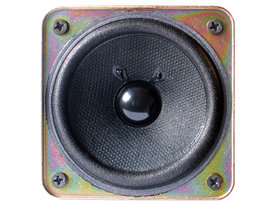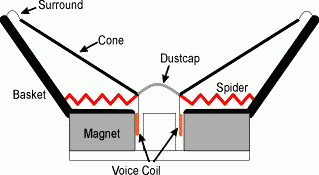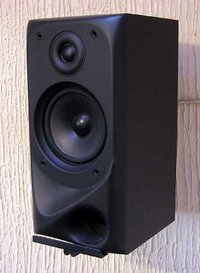Speakers
A loudspeaker, or simply speaker, is an electromechanical transducer which converts an electrical signal into sound. more...
The term loudspeaker is used to refer to both the device itself, and a complete system consisting of one or more loudspeaker drivers (as the individual units are often called) in an enclosure. The loudspeaker is the most variable element in an audio system, and is responsible for marked audible differences between systems.
History
Nikola Tesla is believed to have put electrically charged carbon dust in a cup-shaped device to create the first telephone loudspeaker. However, the first documented device that might fit this description was created in 1881.
Alexander Bell patented the first loudspeaker as part of his telephone in 1876. This was soon followed by an improved version from Ernst Siemens in Germany and England (1878). The modern design of moving-coil loudspeaker was established by Oliver Lodge in England (1898).
The moving coil principle was patented in 1924 by two Americans, Chester W. Rice and Edward W. Kellogg. There is some controversy in that an application was made earlier by the Briton Paul Voigt but not granted until later. Voigt produced the first effective full range unit in 1928, and he also developed what may have been the first system designed for the home, although using electromagnets rather than permanent magnets.
These first loudspeakers used electromagnets because large, powerful permanent magnets were not freely available at reasonable cost. The coil of the electromagnet is called a field coil and is energized by direct current through a second pair of terminals. This winding usually served a dual role, acting also as a choke coil filtering the power supply of the amplifier which the loudspeaker was connected to.
The quality of loudspeaker systems until the 1950s was, to modern ears, very poor. Developments in cabinet technology (e.g. acoustic suspension) and changes in materials used in the actual loudspeaker, led to audible improvements. For Example, Paper cones (or doped paper cones, where the paper is treated with a substance to improve its performance) are still in use today, and can provide good performance. Polypropylene and aluminium are also used as diaphragm materials. Additional improvements to loudspeaker technology occurred in the 1970s, with the introduction of higher temperature adhesives, improved permanent magnet materials, and improved thermal management.
Dynamic loudspeakers
The traditional design is a semi-rigid paper fiber cone and a coil of fine wire (usually copper), called the voice coil attached to the apex of the cone. A "gap" is a small circular hole, slot or groove which allows the voice coil and cone to mave back and forth. The coil is oriented coaxially inside the gap made with a permanent magnet. The gap is also where the magnetic field is concentrated. One magnetic pole is outside the coil, whilst the other is inside the voice coil. In addition to the magnet, voice coil, and cone, dynamic speakers usually also include a suspension system to provide lateral stability and make the speaker components return to a neutral point after moving. A typical suspension system includes the 'spider', which is at the apex of the cone, often of 'concertina' form; and the 'surround', which is at the base of the cone. The parts are held together by a chassis or basket.
Read more at Wikipedia.org




